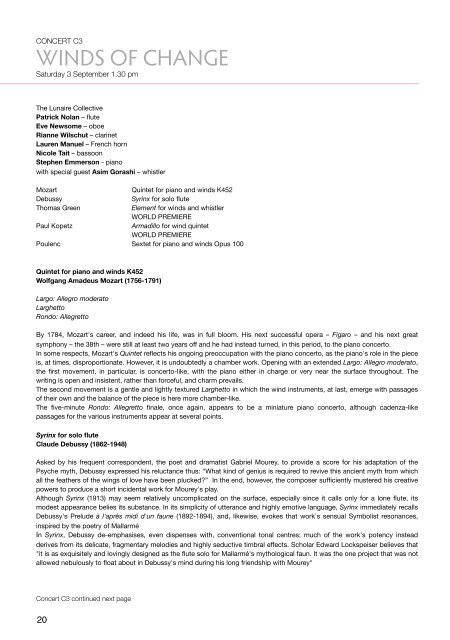Here - Tyalgum Festival of Classical Music
Here - Tyalgum Festival of Classical Music
Here - Tyalgum Festival of Classical Music
You also want an ePaper? Increase the reach of your titles
YUMPU automatically turns print PDFs into web optimized ePapers that Google loves.
CONCERT C3<br />
WINDS OF CHANGE<br />
Saturday 3 September 1.30 pm<br />
The Lunaire Collective<br />
Patrick Nolan – flute<br />
Eve Newsome – oboe<br />
Rianne Wilschut – clarinet<br />
Lauren Manuel – French horn<br />
Nicole Tait – bassoon<br />
Stephen Emmerson - piano<br />
with special guest Asim Gorashi – whistler<br />
Mozart<br />
Quintet for piano and winds K452<br />
Debussy<br />
Syrinx for solo flute<br />
Thomas Green<br />
Element for winds and whistler<br />
WORLD PREMIERE<br />
Paul Kopetz<br />
Armadillo for wind quintet<br />
WORLD PREMIERE<br />
Poulenc Sextet for piano and winds Opus 100<br />
Quintet for piano and winds K452<br />
Wolfgang Amadeus Mozart (1756-1791)<br />
Largo: Allegro moderato<br />
Larghetto<br />
Rondo: Allegretto<br />
By 1784, Mozart's career, and indeed his life, was in full bloom. His next successful opera – Figaro – and his next great<br />
symphony – the 38th – were still at least two years <strong>of</strong>f and he had instead turned, in this period, to the piano concerto.<br />
In some respects, Mozart's Quintet reflects his ongoing preoccupation with the piano concerto, as the piano's role in the piece<br />
is, at times, disproportionate. However, it is undoubtedly a chamber work. Opening with an extended Largo: Allegro moderato,<br />
the first movement, in particular, is concerto-like, with the piano either in charge or very near the surface throughout. The<br />
writing is open and insistent, rather than forceful, and charm prevails.<br />
The second movement is a gentle and lightly textured Larghetto in which the wind instruments, at last, emerge with passages<br />
<strong>of</strong> their own and the balance <strong>of</strong> the piece is here more chamber-like.<br />
The five-minute Rondo: Allegretto finale, once again, appears to be a miniature piano concerto, although cadenza-like<br />
passages for the various instruments appear at several points.<br />
Syrinx for solo flute<br />
Claude Debussy (1862-1948)<br />
Asked by his frequent correspondent, the poet and dramatist Gabriel Mourey, to provide a score for his adaptation <strong>of</strong> the<br />
Psyche myth, Debussy expressed his reluctance thus: "What kind <strong>of</strong> genius is required to revive this ancient myth from which<br />
all the feathers <strong>of</strong> the wings <strong>of</strong> love have been plucked?” In the end, however, the composer sufficiently mustered his creative<br />
powers to produce a short incidental work for Mourey's play.<br />
Although Syrinx (1913) may seem relatively uncomplicated on the surface, especially since it calls only for a lone flute, its<br />
modest appearance belies its substance. In its simplicity <strong>of</strong> utterance and highly emotive language, Syrinx immediately recalls<br />
Debussy's Prelude à l'après midi d'un faune (1892-1894), and, likewise, evokes that work's sensual Symbolist resonances,<br />
inspired by the poetry <strong>of</strong> Mallarmé<br />
In Syrinx, Debussy de-emphasises, even dispenses with, conventional tonal centres; much <strong>of</strong> the work's potency instead<br />
derives from its delicate, fragmentary melodies and highly seductive timbral effects. Scholar Edward Lockspeiser believes that<br />
"it is as exquisitely and lovingly designed as the flute solo for Mallarmé's mythological faun. It was the one project that was not<br />
allowed nebulously to float about in Debussy's mind during his long friendship with Mourey"<br />
Concert C3 continued next page<br />
20



